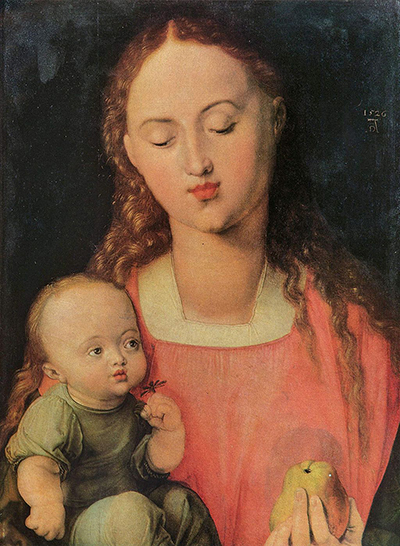This depiction of the Madonna is dated at 1526, by which point the artist had covered her in a whole host of different artworks, including other oil paintings plus woodcuts and etchings. Religious themes would dominate Durer's oeuvre, with Madonna and Child being the most frequent theme of all.
This painting is one of several in which the Madonna and Child are pictured alongside either a pear, or a slice of pear. The symbolic role of the fruit was to represent either love or the purity of the soul. In some examples the child himself will hold parts of a pear where as in this example the artist decides to place the whole fruit in the Madonna's left hand. It may have even been an afterthought, as notice how the hand appears from below but without any arm visible, making it an easy addition if Durer had indeed placed it in at the end of his work. The work itself has been displayed at the Uffizi for many centuries, underlining the maturity of this gallery but also the long period which has passed since this artist first dominated the German art scene all those centuries ago. It is extraordinary that someone could impress as far back as the 15th and 16th century and still have his technical work highly respected and loved today, but that is what Durer has managed.
The Madonna's gaze downwards with a somewhat serious expression represents her looking over the young child, ensuring his protection. The baby appears to be sitting on something which is not revealed within the composition, allowing a more comfortable posture for his mother. She wears a simple pink outfit with white detail around her neck. Her hair is long and curly, without any extravagant style, but neat nonetheless. The child is dressed in a pea green outfit, covering most of his body other than some plump arms. Both have lips which are noticeably narrow. Their foreheads also seem somewhat oversized to what one might have expected. The background is a dark green tone which allows their bright faces to dominate our attention and the artist then signs the piece in his customary fashion on the top right hand side of the piece.
This painting can be found within the Uffizi gallery in Florence, Italy, though their own website does not feature much information on it. You can also find the more famous Adoration of the Magi here as well, though their focus overall is more on Italian artists. This world famous gallery hosts one of the finest selections of Italian Renaissance art anywhere in the world, and is fittingly located in Florence, the city where it all first began. Those interested in learning more about the region's artistic dominance over an extended period of time will also be interested in other artworks displayed here, such as Artemisia Gentileschi's Judith and Holofernes, Paolo Uccello's The Battle of San Romano as well as two of Sandro Botticelli's most famous paintings, namely Primavera and The Birth of Venus. There is plenty more besides to enjoy here, including the stunning architecture in which the collection is housed.




